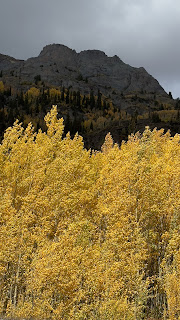Since we arrived in Ouray after dark, we were in for quite a shock when we went out to the car today. What beautiful scenery surrounds this town of less than 1,000, nestled in the San Juan Mountains at 7,800 feet. Nicknamed the “Switzerland of America,” we were pleased with the local vibe. The coffee shop was excellent, and the side streets were still gravel and dirt.
Going south out of Ouray, we entered the “Million Dollar Highway,” a scenic and treacherous mountain road that runs through the heart of the San Juan Mountains to Silverton. Once again, we didn’t see any wildlife, but we were in for a real treat as the aspens were nearly at peak fall foliage. The road climbs up and over three mountain passes so elevation change is constant. The higher up we went, the fewer trees; the lower we went, the trees were patchier in color. The drive isn’t for the faint of heart—there aren’t guardrails, and the drop offs are steep and immediate. The highway department likes not having guardrails as it makes snow plowing easier. A short time after heading up the route, we came to Bear Creek Falls. If you’ve followed me on previous trips, you know how I love waterfalls, so I was quite pleased to be able to see one this trip. And a little further south, we discovered a wonderful cascade (not quite a waterfall) of Red Mountain Creek. The water was a muddy, brown/orange color and it was babbling quite ferociously.
A little further south we came to Crystal Lake which was ensconced in aspens. The wind was also fiercely blowing (had to have been 35-40 mph) out of the south, coming across the lake, and causing me to brace myself like a tripod to get some shots. The groves of aspen here were quaking feverishly in the gale, but their contrast to the gray mountains and blue sky was unbelievable. I’ve never experienced anything like it before—the pictures speak for themselves.
The highway continued and we approached the old mining town of Ironton, a ghost town that is part of the Red Mountain Mining District. We didn’t get a chance to go explore it, but it was easy to envision miners working in the area. Further along at the Red Mountain Pass, we reached the highest elevation of our journey: 11,018.
As we began a slight descent, we arrived at Silverton, a town of about 625. It boomed during the silver rush in the late 1870s and 80s. After the silver market crashed, gold mining entered the town bringing a new boom. The gold market crashed in 1907 and Silverton’s decline began. As we arrived in town, the Durango and Silverton Narrow-Gauge Railroad arrived with repeated horn blows amidst billowing steam from the engine. We made our way to the Lacey Rose Saloon for lunch and were treated to a live piano player, plunking out great tunes in a ragtime fashion. The saloon just opened earlier this summer and is inside the Grand Imperial Hotel.
Knowing we still had quite a drive ahead of us, we gassed up and headed south towards Durango. The elevation lowered and the yellow aspens were exchanged for green ones due to higher temperatures. We finally saw some wildlife south of Pagosa Springs, but it was just regular deer; nothing we couldn’t see back home. As we got closer to Santa Fe, a rather substantial thunderstorm appeared above and beyond the Sangre de Cristo Mountain Range to the east. When we arrived in Santa Fe, we went straight to dinner at Tomasita’s, known for its amazing New Mexican cuisine, particularly its chile (red sauce). A short time later we were at our hotel, where we’ll stay for two whole nights! We explore Santa Fe tomorrow.
























































No comments:
Post a Comment